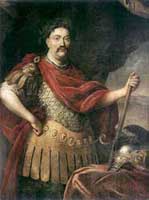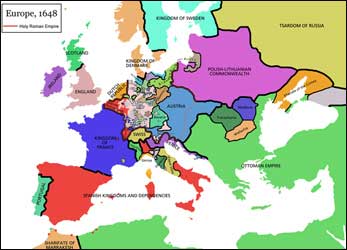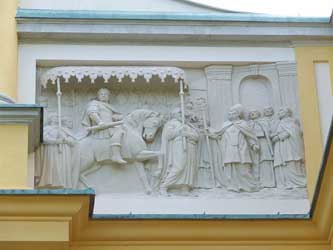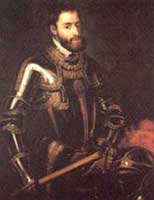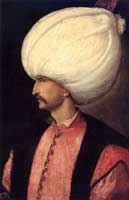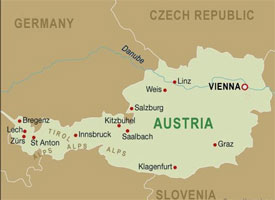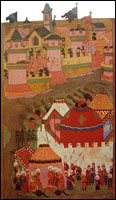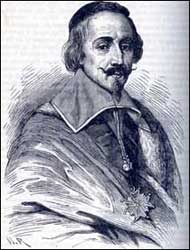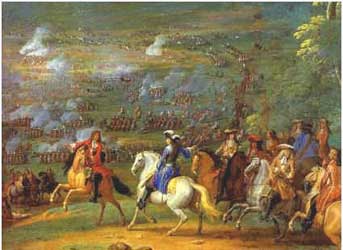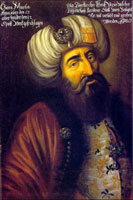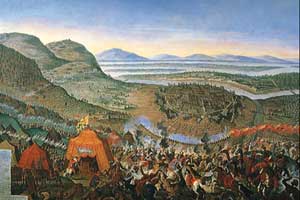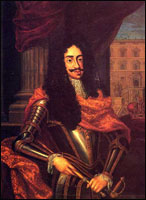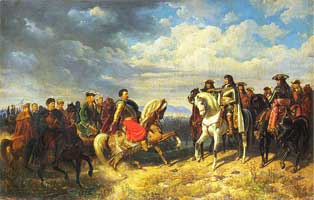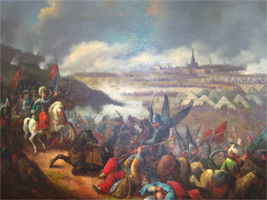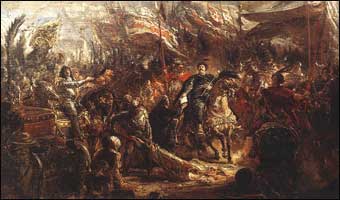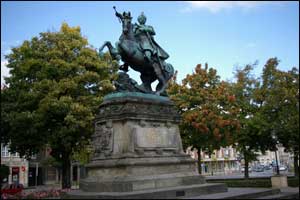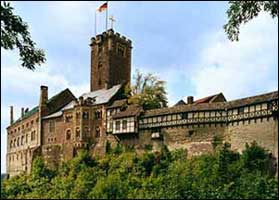By his HEROIC relief of Vienna during the 2nd Muslim siege of that city, King Jan III Sobieski saved Germany from a fate far WORSE THAN DEATH.
By September 11, 1683, a huge Muslim army had Vienna surrounded and were ready to take the city by storm. Their FINAL TARGET was Germany–the birthplace of Saint Martin Luther and the homeland of the Reformation.
|
For defeating the Muslims, and granting religious liberty to all her subjects, that Republic later disappeared from the map of Europe.
The Polish-Lithuanian Commonwealth was one of the largest nations in Europe and her people were only equaled by heroic Holland in the liberties granted to her subjects.
The Polish-Lithuanian Commonwealth had a parliament where the king was elected to the throne.
|
Religious toleration was guaranteed to all–an unheard of idea except for the tiny Dutch Republic.
After the blessed Reformation commenced on October 31, 1517, Old Rome was determined to stop it at any cost. By 1529, the Reformation had spread rapidly throughout Europe and especially into the vast state known as the Polish-Lithuanian Commonwealth:
The Protestant Reformation began during the reign of Zygamunt I (1502–1548) and proved attractive to many Polish-Lithuanian citizens. There were few pressing issues, since Polish monarchs already had the right to appoint bishops without papal interference and keep Church taxes at home. But papal support for the Teutonic Knights and opposition to Czech Hussites had alienated many Poles and Lithuanians. And the Church's wealth remained a tempting target, even though it owned much less arable land in Poland-Lithuania (10-12 percent) than it did in western European countries such as England (40 percent). Still, Church holdings were substantial. The possessions of the archbishopric of Gniezno (292 villages and 13 cities) and the bishopric of Cracow (225 villages and 11 cities) put their appointees among the wealthiest nobles in Poland, with eight to ten times the possessions of most great secular lords; other bishops and monastic orders also owned large estates. Many educated Poles and Lithuanians wanted to see the Bible translated into their own language, and some of the clergymen wanted to marry. (Stone, The Polish-Lithuanian State, 1386-1795, pp. 41-42).
Even though the Vatican owned 10-12 percent of real estate in the Poland-Lithuanian Commonwealth, that was enough for them to fear the loss of their income from the huge estates.
To this end, the Pope called on Sultan Suleiman to invade Germany, and destroy the reforming work of Saint Martin Luther.
Vienna was the key to the conquest of Germany, and Muslim possession of that city would open the way to the subjugation of both Austria and Germany.
The first siege of Vienna by the Muslim Turks occurred in 1529
On May 10, 1529, a huge army of over 250,000 men and 300 cannon set out from Constantinople. This vast army was led by Sultan Suleiman I. Suleiman is called the "MAGNIFICENT" by the Latin West.
By the conquest of Constantinople, Suleiman claimed the title Emperor of the Romans. Charles V also claimed that title. Like King Herod and Pontius Pilate, they could work together to condemn the innocent!
|
Vienna was the key to the conquest of Germany, and Muslim possession of that city would open the way to the subjugation of both Austria and Germany.
|
Our great JEHOVAH came to the help of his servant Martin Luther, by opening the windows of heaven, and causing an incessant rain to slow the progress of the invading Muslims:
As for the roads, which by modern standards were extremely bad at the best of times, the combination of incessant rain and the passage of an army of 250,000 men with their wagons, artillery, horses, mules and camels turned them into quagmires. It was not unusual in the early sixteenth century for roads in countries as civilized and comparatively advanced as France, for instance, to become so bad in winter that those who were foolhardy enough to travel upon them risked being drowned in enormous waterlogged pot-holes or great morasses of liquid mud. It can be imagined, therefore, what a summer like that of 1529, combined with the passage of Suleiman's army, did to the roads of eastern Europe: men slithered and squelched in the mud; wagons and cannon got bogged down and had to be abandoned; horses, mules and camels fell and broke their legs, or stood, stubborn and shivering, while their grooms swore at them and tried to drag them another few yards along the eight-hundred-mile journey upon which they were embarked. (Bridge, Suleiman the Magnificent, p.113).
It was not until September 23 that the waterlogged invading host finally reached Vienna:
Without heavy artillery the Turkish bombardment, which began at once, did little damage to the fortifications of Vienna, old-fashioned as they were, and von Salm felt safe enough at the top of the tall spire of St Stephen's Church, from which vantage point he could watch every movement of the enemy outside the city walls; if a stray ball hit the spire, it was too small and spent to do much harm, and the Count spent most of his time there. The Turks realized that they would never breach the walls by using their artillery alone, and they began mining operations early in the siege, driving shafts beneath the Carinthian Gate and the monastery of St Clare; but some prisoners taken during another sortie on 6 October gave away the secret of these mines, and counter-mines were begun immediately by some German sappers and blown successfully a few days later. (Bridge, Suleiman the Magnificent, p.116).
On October 16, Sultan Suleiman decided that maybe Allah didn't will it after all and abandoned the siege. His entire army retreated to Constantinople, harassed every step of the way by the victorious Austrians and Germans. His losses were about 40,000 men.
No further attempts were made to invade Germany until the 30 Years' War beginning in 1618.
The 30 Years' War was an attempt to subjugate Reformation Germany
In 1618, a fearful struggle began among the nations of Europe. Engineered by the Jesuits to destroy the Reformation in Germany, it caused the deaths of countless millions, and Germany's population was reduced by over one half.
The Jesuit engineered 30 Years' War was one of the most savage conflicts in the history of the world and no slaughter of such magnitude appeared until WWI.
The U.S. Civil War was a bloody conflict, but that war lasted only 5 years, and the antagonists did take prisoners. Multiply that conflict by SIX and you get some idea of what the war was like.
|
The terrible conflict was mostly confined to Germany, but most countries sent mercenaries to fight on either side.
When all hope was gone and the imperialists were preparing to invade Germany and completely destroy the Reformation, JEHOVAH raised up a champion to save the Christians from complete extinction. His name: King Gustavus of Sweden—the Lion of the North.
|
The 30 Years' War only ended because Spain was facing bankruptcy. The Peace of Westphalia was only a temporary truce as the Papacy would not rest until the Reformation was totally destroyed in Europe.
The Peace of Westphalia in 1648
Of course the Jesuit general was delighted with the death of the king of Sweden. His rejoicing was turned into mourning however when the French entered the conflict. The imperialists were deemed invincible but the victories of King Gustavus encouraged the French to help the Swedes.
|
The French won many victories, and finally the war was ended with the Peace of Westphalia in 1648.
When the war ended with the Peace of Westphalia in 1648, there was nothing left to fight over. Europe was ruined....France emerged the clear winner under the leadership of Cardinal Richelieu. The unholy Roman Empire was greatly weakened and Spain was forced to sign a peace treaty with Holland ending the 80 Years' War.
The Second Siege of Vienna by the Muslim Turks in 1683
The Peace of Westphalia that was signed by the warring nations of Europe was very, very displeasing to the Jesuit general. He called on his Muslims once again to invade Germany and replace the churches with mosques.
|
The Muslim army of over 300,000 men was commanded by a ruthless Turk named Kara Mustafa Pasha. 2 months before the siege began, Emperor Leopold I left the city with his entire family. He was one captain that was determined NOT to go down with his ship.
|
The little garrison of 15,000 defenders were vastly outnumbered by the Muslims. In late afternoon on September 12, the king of Poland led his Hussars in a wild charge into the headquarters of the Grand Vizier. Panic ensued, and the Muslim army began to flee; hotly pursued by Sobieski and his dragoons.
Like Alexander the Great at the Battle of Issus, Sobieski charged straight for the pavilion of the Grand Vizier. His left wing was commanded by the German Elector of Saxony, Duke John George III. This was one of the most important battles in the history of the world yet it is never mentioned in the history books.
|
It was the WORST news that the pontiff ever received!! His own Muslims had failed to capture Vienna and thereby Germany was saved.
Kara Mustafa Pasha escaped with his life but was later strangled and beheaded for losing the battle.
What if Germany had fallen to the Terrible Turks??
If Germany had fallen to the Muslims, the very memory of the Reformation would have been permanently expunged from the history books along with all the writings of the great Reformer.
|
Of course there would be no Reformation Online to present the great career of the fearless Reformer, and there would be no United States of Israel in existence.
Vital Link
References
Bridge, Antony. Suleiman the Magnificent. Franklin Watts, New York, 1983.
Pogonowski Iwo Cyprian. Poland An Illustrated History. Hippocrene Books, Inc;, New York, 2000.
Palmer, Alan. The Decline and Fall of the Ottoman Empire. M. Evans & Company, New York, 1992.
Stone, Daniel. The Polish-Lithuanian State, 1386–1795. University of Washington Press, 2001.
Stoye, John. The Siege of Vienna. The Last Great Trial Between Cross & Crescent. Pegasus Books, New York, 2006.
Copyright © 2014 by Patrick Scrivener
